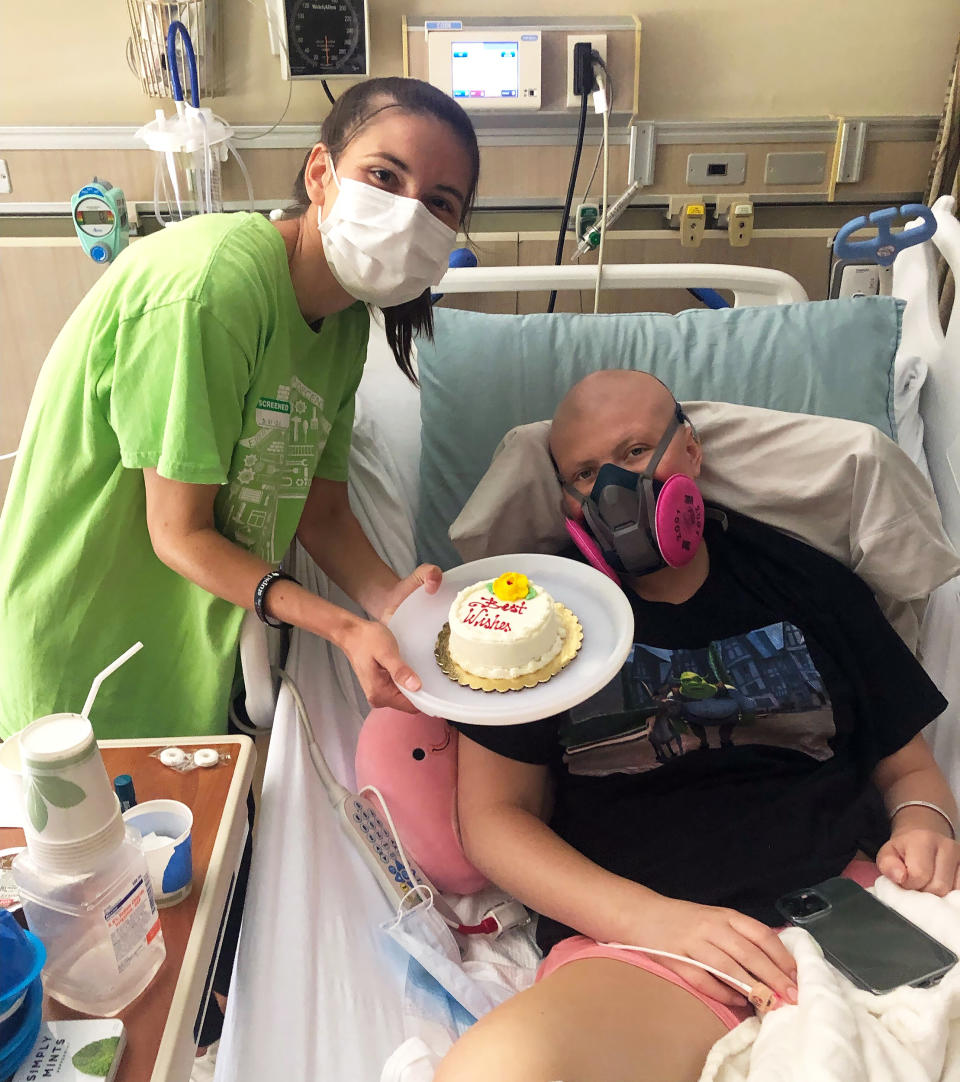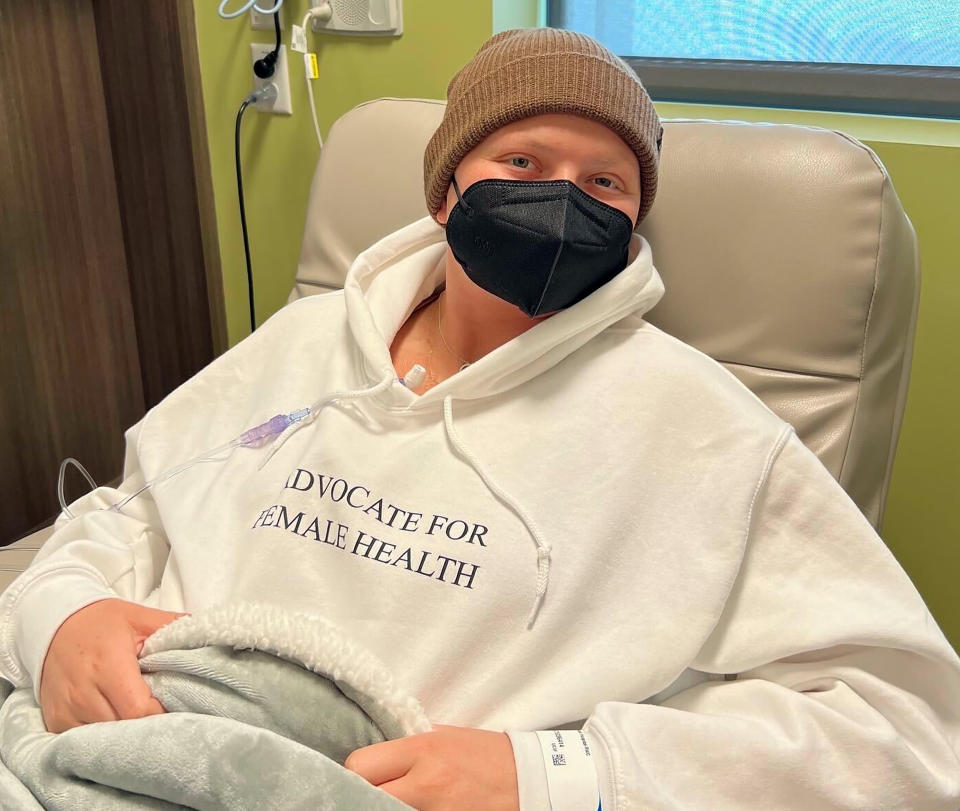21-year-old's pain was dismissed by doctors for years. She had a rare ovarian cancer
- Oops!Something went wrong.Please try again later.
- Oops!Something went wrong.Please try again later.
Sharp abdominal pain struck Jessie Sanders' body. For almost two weeks in November 2021, she couldn't eat, work out or move. All she did was lie in bed.
Then, the day after Thanksgiving 2021, Sanders, 21, finally drove herself to the emergency room. She was fed up with the pain. Her weight had dropped a lot. What frustrated her most was that she couldn't eat her Thanksgiving dinner.
She made the difficult decision to go to the hospital — she'd been dismissed for her pain many times before — and underwent emergency surgery for an ovarian cyst. A week later, she got a call from the surgeon. She learned she had small cell carcinoma of the ovary, hypercalcemic type — a very rare, aggressive form of cancer.
“I thought I was crazy having these pains (because) doctors always (dismissed) my pain,” Sanders tells TODAY.com. “I was having very severe abdominal pain for two weeks, and I couldn’t eat. I couldn’t go do things because it was so severe.”
Years of abdominal pain, dismissed
Sanders began experiencing chronic abdominal pain five to six years ago. When she was 15, she went to an OB-GYN for the first time for her symptoms and was told to try birth control. She recalls them telling her not to worry because it was just her body changing.
Her pain varied week to week, but she never went more than a few days without any. In high school, it was sometimes so bad that she couldn’t go to class. Her mom or dad would pick her up and drive her to the doctor, but it was always dismissed as period cramps.
When she got to college, Sanders occasionally had to sit out of soccer practice or games.

“I was always so frustrated because the thing that ... doctors always assume is you’re pregnant or it’s just hormones or it’s your menstrual cycle,” Sanders says. “And I’m just like, ‘No, it’s not. I know there’s something else wrong with my body.’”
By Thanksgiving during her junior year at San Diego State University, her pain got so severe that she overcame her fear that doctors would dismiss her once more, and she went to the hospital.
When Sanders arrived at Kaiser Zion Medical Center in San Diego, doctors discovered a 17-centimeter cyst on her right ovary. They rushed her into emergency surgery and removed the cyst, along with her right ovary, which the cyst had wrapped around and killed.
Afterward, Sanders recovered at home. Pain from the surgery itself was the only discomfort she felt, and it lasted just a few days. She went back to playing Division 1 soccer and pursing a psychology degree.
When the surgeon called a week later, she was told to come into the office and bring family. Her mom, Lisa, sister and dad all flew in from her home town of San Carlos, California.
“It was just so unbelievable that my incredible, healthy daughter could have cancer,” Lisa Sanders tells TODAY.com. “It just didn’t compute right.”

Finding the right treatment
Jesse Sanders' type of ovarian cancer is especially unusual because it affects much younger women than the more common types of ovarian cancer, Dr. Kathleen Schmeler, executive director of global health at The University of Texas MD Anderson Cancer Center, tells TODAY.com. By the time most patients, usually between 15 and 39 years old, are diagnosed, the cancer has spread to other parts of the body. (Fortunately, Jessie Sanders' cancer had not.)
“Most of the time, people don’t think it’s necessarily cancer because the women are so young,” Schmeler says. “No one does a lot of testing because they’re so young, and it’s so unlikely that they would have ovarian cancer.”
After Jessie Sanders' diagnosis, she met with a doctor in San Diego to create a treatment plan. Sander's mom says she asked the doctor if they were open to hearing about any other research or information.
"She pretty much said, 'No, this is our protocol. This is what we do,' Lisa Sanders recalls the doctor telling. "It was really hard first meeting to be shut down. ... I didn't do a WebMD search. ... I had legitimate resources from good sources, and I was just shut down so hard."
The same afternoon, a friend put Lisa Sanders in touch with Dr. Joseph Pressey, co-director of the young adult oncology program at Cincinnati Children's hospital. Pressey's helped treat about 70 cases of small cell carcinoma of the ovary, hypercalcemic type. Pressey estimates that only a few hundred patients with this type of cancer have been documented in medical journals.
“Obviously an extremely rare ovarian cancer isn’t at the top of people’s minds when they’re seeing somebody who’s starting to have symptoms," Pressey tells TODAY.com "I think the question becomes, if someone has persistent symptoms.”
Pressey confirmed that Jessie Sanders' first treatment plan was inadequate. Instead, he recommended that her treatment be approached similarly to pediatric cancer, with high doses of chemotherapy, and oftentimes surgery and a bone marrow transplant.
"It's so hard to realize how much you have to advocate for yourself, and what if I never met Dr. Pressey?" Lisa Sanders recalls. "How would I know we were on the wrong treatment? It's scary."

In December, while home for winter break, Jessie Sanders started chemo at Redwood City Kaiser Oncology. For eight hours a day, three days a week, for three weeks, she sat in a chair next to other cancer patients. Often, she was the youngest person in the room. She lost her hair, developed neuropathy, losing feeling in her feet and hands, and was nauseous for six months.
“It was just really hard because I’m 20 years old, and I’m on social media, trying to pass the time, and I’d see my friends are traveling, or they’re out practicing and doing normal things that I should be doing,” Jessie Sanders says.
After completing six rounds of chemo, she moved to Stanford Hospital for a three-week long bone marrow transplant.
The treatment was hard on her body; some days she could barely move or get out of bed. Her mom says the nurses told her it was the highest dose of chemotherapy that they’d ever given anyone.
“There’s some really hard moments where she was having a reaction to some of the medicine, and her heart was racing, and she started convulsing,” Lisa Sanders says. “I was just thinking, 'This is the moment where I lose my daughter.'”

Remission and raising awareness
While going through treatment, Jessie Sanders posted a video of her shaving her head on TikTok. Although doing so was scary for her, soon her phone flooded with comments.
People reached with suggestions about cold capping (a treatment to prevent hair loss due to chemo) and what type of beanies to wear. British broadcaster Will Buxton sent her a video wishing her the best of luck with treatment. But what struck Jessie Sanders most is that people were curious about her story.
Inspired, she filmed another video where she discussed her symptoms and diagnosis. After posting it, she said young women were commenting left and right that they, too, had been dismissed for their abdominal pain.
“I’m so frustrated for myself and for other women," Jessie Sanders says. "I don’t want them to have their health care dismissed. I just need to get the word out. I want other people to be inspired to just advocate for themselves.”
So, Sanders began Fight for Female Health, an organization that sells T-shirts and sweatshirts to raise money for the Small Cell Ovarian Cancer Foundation. She also uses it to raise awareness of the symptoms of ovarian cancer and encourage early detection and ultrasounds at the OB-GYN. Sanders hopes that by sharing her story, she'll teach people that ovarian cancer can happen at any age, and that it’s not detected by pap smears.

Jessie Sanders is now in full remission. She’s been out of the hospital for about five months. In July, she went back to San Diego State University for her last year of playing soccer, though her body and life are not the same. Instead of worrying about the normal college things like parties, she now worries about her fertility — and all the other young women whose cancer symptoms are being dismissed.
"It's really important for all women to know their bodies and when something's not right, and if it's not right, then to see a health care provider and ... if they feel like they're being dismissed, to change to someone else," Jessie Sanders says. "Nobody should be dismissing patients, not looking into whatever was causing (me) to have all those symptoms. Clearly something wasn't right."
This article was originally published on TODAY.com

